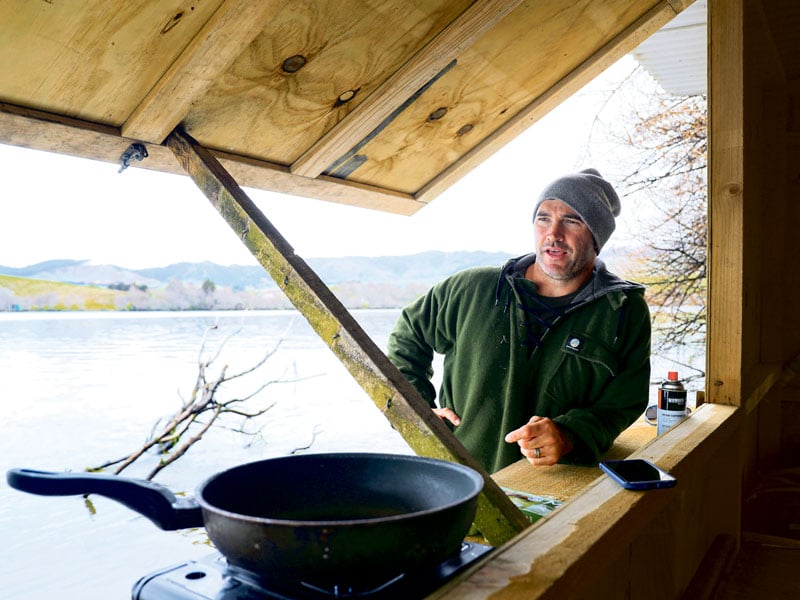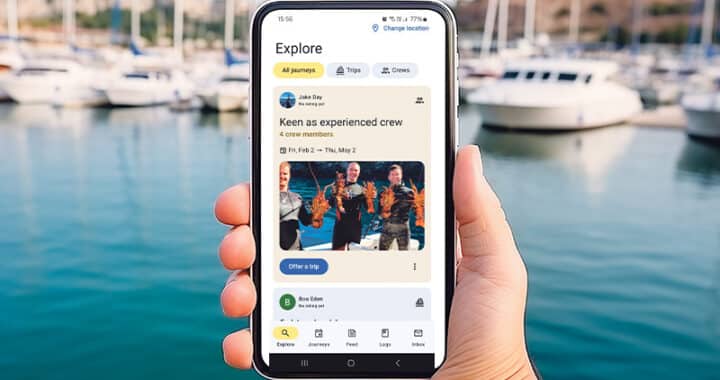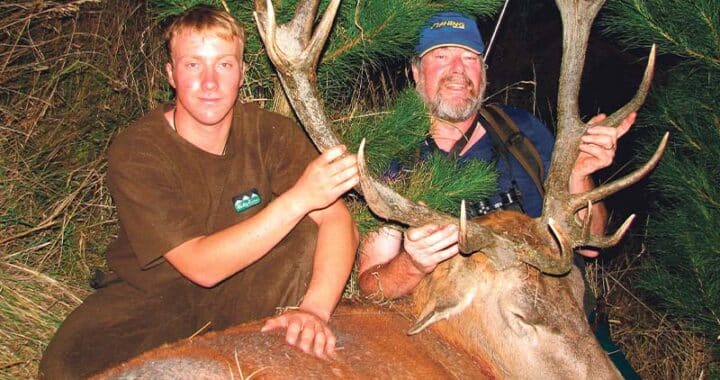Whitebaiting with an All Black
4 min read
Cameron’s tour guide for the day: Stephen ‘Beaver’ Donald. Photo: Simon Watt
Not that anyone heading off upriver whitebaiting would give a stuff, but at the Waikato River mouth, there is no cellphone reception. Like I say, this wouldn’t be a significant blow to any keen whitebaiting weekend tale of glory normally. On the contrary, a day or two away from the incessant chiming of a mobile phone would usually be seen as a blessing. Thing is, that lack of 21st Century convenience became part of the legend of the bloke showing me the ropes out there on the water.
I mean, if you’re going to give whitebaiting a go for the first time, you should probably make sure whoever you’re heading out on the water with knows their stuff. Better still, if the guy holding the net and operating the gas cooker is a bona fide legend of New Zealand rugby with a few tales to tell, even better.
Through a strange quirk of fate (me spending most of my professional life writing about cars, him being an ambassador for a car brand), it just so happens that Stephen ‘Beaver’ Donald was my tour guide through the boggy islands of the Waikato River mouth delta.
He’s a Waiuku lad through-and-through and has been whitebaiting on the Waikato River and at the southern end of nearby Karioitahi Beach most of his life. When he hasn’t been saving World Cup Rugby championships and – latterly – playing rugby up in Japan, that is.
At an undisclosed location within the vast stretches of waterlogged islands dotted with whitebait stands (some relatively homely with potbelly stoves, old couches, and benchtops; some jury-rigged together and little more than three sides of a corrugated tin shed you might normally find housing firewood in a suburban back yard) lies Beaver’s own stand.
It’s a midway point between the two prevailing styles: little more than a simple unadorned box on its own island but fashioned out of clean plywood and solid framing timber, with plenty of room to stand inside out of the elements when the net has been cast out into the current.
With the whitebait running slowly at first, I can immediately see why they’re called ‘stands’. You do a lot of that, hands in pockets and bracing yourself against the breeze. Thankfully, Beaver is an amiable host, full of advice and – more importantly – good yarns.

It’s true that he was here in this very spot when, reeling from a succession of high-profile injuries to the 2011 RWC squad, All Blacks coach Graham Henry desperately tried to get hold of the solid first five-eighth on the phone. He’d been dropped following the 2010 season in favour of Colin Slade, but with Slade injured and only Aaron Cruden at match-fit level (with Dan Carter also on the sideline with a groin injury), Henry needed the big boot of Beaver back in the fold. Immediately.
“I got back to the ute and there were a dozen missed calls on the mobile,” he laughs.
“I still made it in time of course. I was surprised but very pleased to be back on the field, even on the sidelines as I was to start with.”
The rest is history: Cruden injured 30-odd minutes into the first half of the championship final against old foes France. Donald takes the field, coverts a penalty (now simply referred to in the annals of Kiwi sports folklore as ‘The Kick’) and – a try from Tony Woodcock notwithstanding – effectively wins New Zealand the Webb Ellis Cup by a single point.
Read more: Whitebait estuary runs entice trout, kahawai, and anglers
Read more: The whitebait trout connection
National hero status assured, Beaver humbly went back to playing for both the Waikato provincial team and the Chiefs for many more seasons before venturing to Japan in 2016, where he still plays professionally when global pandemics don’t lay waste to entire footy seasons. But his love of being in the Kiwi outdoors – whether hunting or fishing – is apparent. And when the whitebait is running, Beaver heeds the call. Unfortunately, they were not running all that much on the day of our visit.
The catch from the nets – cast out at both the wild, dramatic Karioitahi shoreline and at Beaver’s stand several left and right turns away by rudimentary speedboat – was slim.
Beaver tells a few fishing tales of hauls that fill chest freezers, although all that was happening was that the westerly was freezing the visiting townie to the bone.
Never fear: a short boat ride away was a mate’s stand, where a gas cooker, a well-greased fry pan, several bags of fresh white bread, bright yellow lemons and, crucially, an enormous brick of “here’s some we caught earlier” whitebait awaited us.
Absolute bloody heaven. Thinking it’d be rude to have more than a couple of whitebait fritters in bread, I somehow find myself downing a fourth. Sitting on an old couch purloined “from a mate’s bar somewhere in Hamilton” and watching the slow-moving river idle by, whitebait fritter in one hand and a steaming mug of the finest instant coffee you can find in a bulk-buy tin in the other, I can all of a sudden see the appeal of this backwater pursuit.

They’re fickle little buggers sometimes, but whitebait never fails to heighten emotions among those that chase them every season and guard their chosen patch on the water ferociously.
Whitebait is white gold, and, like gold, it is capable of generating something akin to a fever in many. Beaver gets it. And sometimes not even the roar of the crowd at the edge of a rugby field would be enough to lure him away from this place.
For information on whitebait season 2020, visit doc.govt.nz.
Words by Cameron Officer



